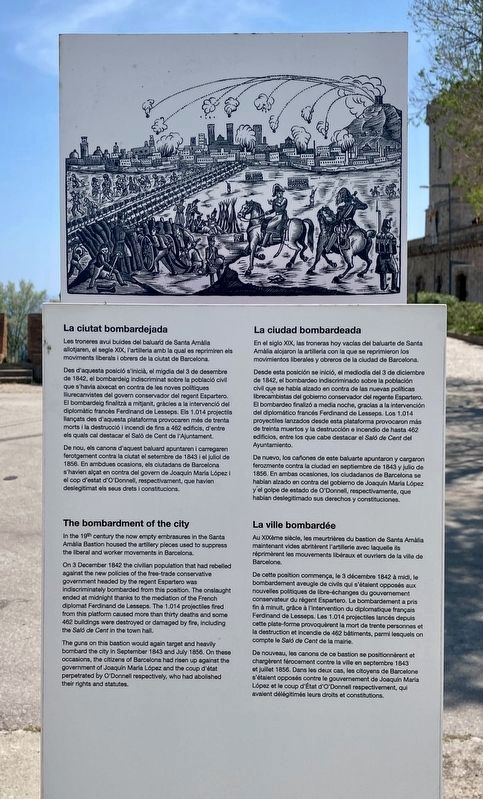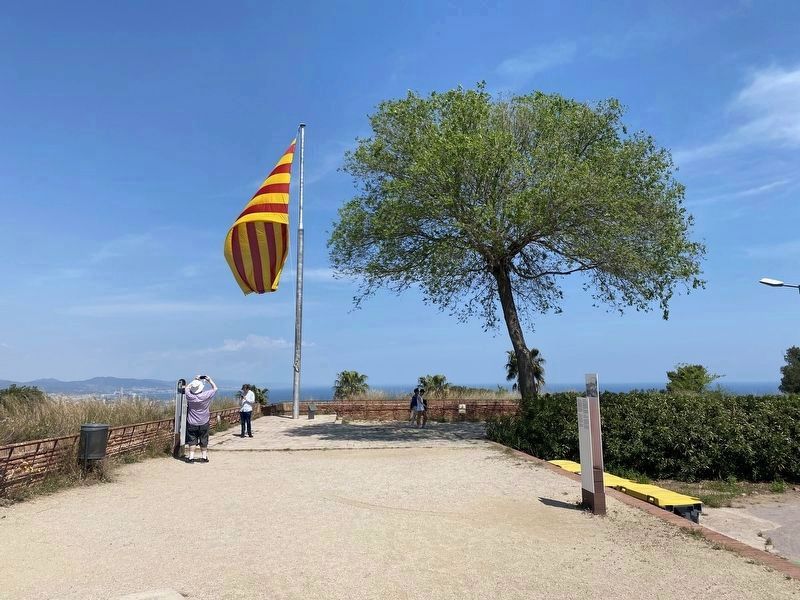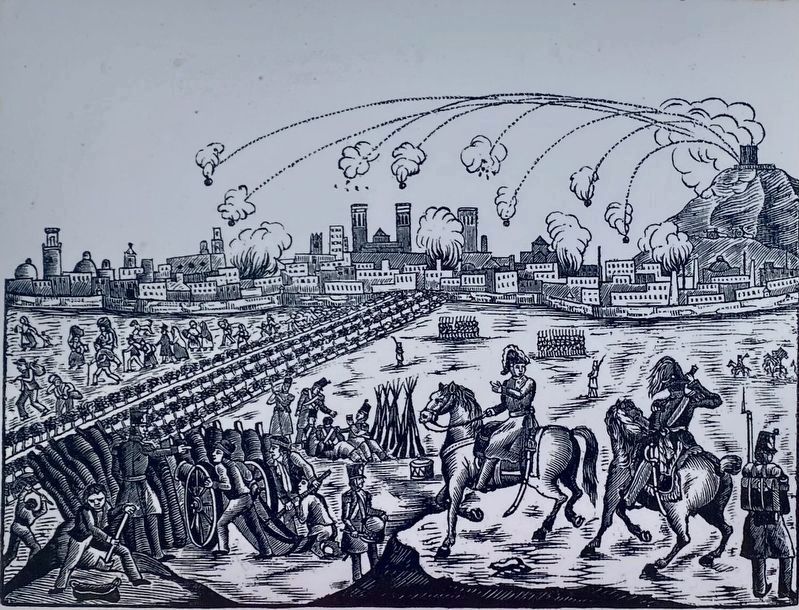Montjuïc in Barcelona, Catalonia, Spain — Southwestern Europe (Iberian Peninsula)
La Ciutat Bombardejada / The Bombardment of the City
La ciudad bombardeada / La ville bombardée
Inscription.
La ciutat bombardejada
Les troneres avul buides del baluard de Santa Amàlia allotjaren, el segle XIX, l’artilleria amb la qual es reprimiren els moviments liberals i obrers de la ciutat de Barcelona.
Des d'aquesta posició s'inicià, el migdia del 3 de desembre de 1842, el bombardeig indiscriminat sobre la població civ que s'havia aixecat en contra de les noves politiques Allie urecanvistes del govern conservador del regent Espartero. El bombardeig finalitzà a mitjanit, gràcies a la intervenció del diplomàtic francés Ferdinand de Lesseps. Els 1.014 projectils llançats des d'aquesta plataforma provocaren més de trenta morts i la destrucció i incendi de fins a 462 edificis, d'entre els quals cal destacar el Saló de Cent de l'Ajuntament.
De nou, els canons d'aquest baluard apuntaren i carregaren ferotgement contra la ciutat el setembre de 1843 i el juliol de 1856. En ambdues ocasions, els ciutadans de Barcelona s'havien alçat en contra del govern de Joaquín María López el cop d'estat d'O'Donnell, respectivament, que havien deslegitimat els seus drets i constitucions.
In the 19th century the now empty embrasures in the Santa Amalia Bastion housed the artillery pieces used to suppress the liberal and worker movements in Barcelona.
On 3 December 1842 the civilian population that had rebelled against the new policies of the free-trade conservative government headed by the regent Espartero was indiscriminately bombarded from this position. The onslaught ended at midnight thanks to the mediation of the French diplomat Ferdinand de Lesseps. The 1.014 projectiles fired from this platform caused more than thirty deaths and some 462 buildings were destroyed or damaged by fire, including the Salo de Cent in the town hall.
The guns on this bastion would again target and heavily bombard the city in September 1843 and July 1856. On these occasions, the citizens of Barcelona had risen up against the government of Joaquin Maria López and the coup d'etat perpetrated by O'Donnell respectively, who had abolished their rights and status.
En el siglo XIX, las troneras hoy vacias del baluarte de Santa Amàlia alojaron la artilleria con la que se reprimieron los movimientos liberales y obreros de la ciudad de Barcelona.
Desde esta posición se inició, el mediodía del 3 de diciembre de 1842, el bombardeo indiscriminado sobre
la población
civil que se habla alzado en contra de las nuevas politicas
librecambistas del gobierno conservador del regente Espartero.
El bombardeo finalizó a media noche, gracias a la intervención
del diplomático francés Ferdinand de Lesseps. Los 1.014
proyectiles lanzados desde esta plataforma provocaron más
de treinta muertos y la destrucción e incendio de hasta 462
edificios, entre los que cabe destacar el Saló de Cent del
Ayuntamiento.
De nuevo, los cañones de este baluarte apuntaron y cargaron ferozmente contra la ciudad en septiembre de 1843 y julio de 1856. En ambas ocasiones, los ciudadanos de Barcelona se habian alzado en contra del gobierno de Joaquin Maria López y'el golpe de estado de O'Donnell, respectivamente, que hablan deslegitimado sus derechos y constituciones.
Au XXXe siècle, les meurtrières du bastion de Santa Amalia maintenant vides abritèrent l’artillerie avec laquelles réprimarent les mouvements libéraux et ouvriers de la vie de Barcelone.
De cette position commença, le 3 décembre 1842 à midi, le bombardement aveugle de civils qui s'étaient opposés aux nouvelles politiques de libre-échanges du gouvernement conservateur du régent Espartero. Le bombardement a pris fin à minuit, grâce à intervention du diplomatique français Ferdinand de Lesseps. Les 1.014 projectiles lancés depuis cette plate-forme provoquèrent la mort de trente personnes et la destruction et incendie de 462 bâtiments, parmi lesquels on compte le Saló de Cent de la mairie.
De nouveau, les canons de ce bastion se positionnent et chargirent férocement contre la ville en septembre 1843 et juillet 1856. Dans les deux cas, les citoyens de Barcelone s'étalent opposés contre le gouvernement de Joaquin Maria Lopez et le coup d'État d'O'Donnell respectivement, qui avaient délégitimé leurs droits et constitutions.
Topics. This historical marker is listed in this topic list: Notable Events. A significant historical date for this entry is December 3, 1842.
Location. 41° 21.862′ N, 2° 9.987′ E. Marker is in Barcelona, Cataluña (Catalonia). It is in Montjuïc. Marker can be reached from Carrer del Castell. Touch for map. Marker is in this post office area: Barcelona, Cataluña 08038, Spain. Touch for directions.
Other nearby markers. At least 8 other markers are within walking distance of this marker. Catalan Flag raised (a few steps from this marker); Montjuic Castle (within shouting distance of this marker); Méchain Etablí les Coordenades de Barcelona / Méchain Establishes the Coordinates of Barcelona (about 90 meters away, measured in a direct line); El Pont d’accés i la façana / The Entrance Bridge and the Façade (about 90 meters away); La torre de guaita / The Watchtower / La torre vigia / La tour de guet (about 90 meters away); El juidici del President Lluís Companys / The Trial of President Lluís Companys (about 90 meters away); El pati d’armes o quadrat / The parade ground or courtyard (about 120 meters away); El baluard de Sant Carles / The Sant Carles Bastion / El baluarte de Sant Carles (about 150 meters away). Touch for a list and map of all markers in Barcelona.
More about this marker. The marker is in Montjuïc Castle on the Santa Amalia Bastion.
Also see . . .
1. The Castel of the 19th century (Ajuntament de Barcelona).
On the bombardments: The popular insurgent movements that emerged during this period were liquidated by the government of Espartero. On 3 December 1842 he ordered the bombardment of the city from the Castle during twelve hours, as punishment for the spontaneous protests. The cannons fired 1014 projectiles and caused at least twenty deaths and widespread destruction throughout the city. By the time the offensive had ceased, to quote an eye witness “the city had taken on a sepulchral aspect: doors and shops closed, the streets almost deserted, in some places obstructed by the ruins and rubble of devastated houses and shrouded by the smoke coming from the many still burning buildings.” The following year, on 2 September 1843, the instatement of the Supreme Provincial Junta provoked a revolt known as la Jamància, demanding a fairer distribution of wealth. On 10 November, Barcelona was again systematically bombarded from Montjuïc, on this occasion for two months, causing 335 deaths, 354 injuries and significant material damage, to the extent that around 40,000 people fled the city. Yet again, in July 1856, the city was shelled from Montjuïc, in conjunction with forces stationed in the Ciutadella and Drassanes this time by order of the Captain General Juan Zapatero, as a consequence of the protests against the military coup that had toppled the progressive government. The city was occupied by the army and the subsequent repression resulted in over 400 casualties.(Submitted on February 28, 2023.)
2. "For the good of Spain, Barcelona must be bombarded once every 50 years" (El Nacional). Newspaper article presenting an overview of Barcelona being bombarded, from the French in 1697 to the Italians in 1938.
Introduction: Barcelona, December 3rd, 1842. The day that General Baldomero Espartero, Regent of Spain for the underage queen, Isabel II - following the resignation from the role of her mother, Queen Maria Cristina de Bourbon, implicated in a slave trade scandal - ordered the indiscriminate bombing of Barcelona. Twenty days earlier, on November 13th, a spontaneous, popular protest had exploded into an urban revolt. Espartero, who had gone to Barcelona to take charge, resolved the matter in the most direct way possible. And he then uttered a phrase that has gone down in history: “For the good of Spain, Barcelona must be bombarded once every fifty years”. A quote that clearly sets out the nature of the relationship between Spain and Catalonia at critical times - and also at less-critical times. Because Espartero's bombardment of the city was neither the first nor the last. In the last four centuries, the Spanish army and its allies have indiscriminately shelled Barcelona a number of times, brutally fleshing out Espartero's prescription.(Submitted on February 28, 2023.)
Credits. This page was last revised on February 28, 2023. It was originally submitted on February 27, 2023, by Andrew Ruppenstein of Lamorinda, California. This page has been viewed 181 times since then and 9 times this year. Photos: 1, 2, 3. submitted on February 27, 2023, by Andrew Ruppenstein of Lamorinda, California.


